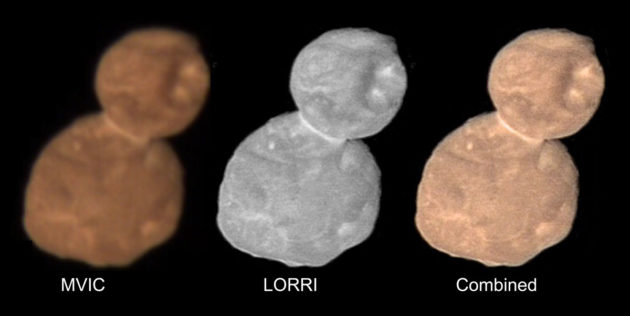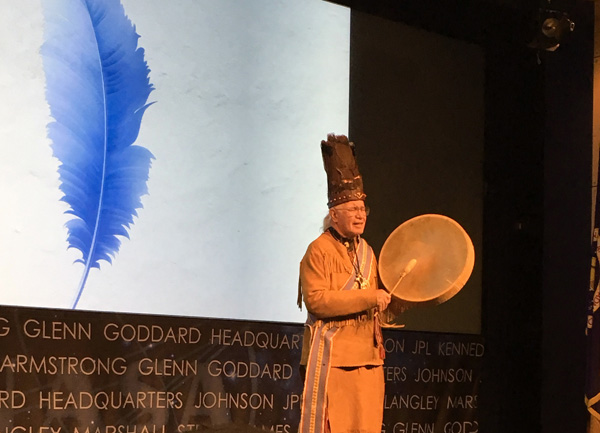When NASA's New Horizons flew by a distant Kuiper Belt Object on New Year's Day, the team nicknamed it "Ultima Thule." Now, the object has received an official moniker: Arrokoth.
The most distant explored body has a new name. Originally referred to as 2014 MU69, the tiny Kuiper Belt object that New Horizons flew by on January 1, 2019, has now been officially named Arrokoth, the word for "sky" in the Algonquian language of the Powhatan people. The new name replaces the temporary nickname “Ultima Thule,” a term proposed in a public naming contest that has served as a placeholder over the past year.

NASA / JHU-APL / SwRI
According to the International Astronomical Union, the group responsible for the official names of celestial bodies, objects beyond the orbit of Neptune are to be given mythological names related to creation. These worlds include Kuiper Belt Objects (KBOs), the small icy population at the edge of the solar system, of which Arrokoth is a part. NASA's New Horizons spacecraft flew by Arrokoth (pronounced AR-uh-koth) on New Year's Day, four years after its successful flyby of Pluto. What was initially thought to be one object turned out to be two attached bodies that look surprisingly like a flattened snowman.
"When thinking about possible names, the first question that crossed my mind was, 'Why do so many KBOs have Polynesian names," said Mark Showalter, leader of the New Horizons nomenclature working group. The reason, he said, is because most of them were discovered by telescopes based out of Hawai‘i, which is dominated by that culture.
In contrast, Arrokoth was spotted by the Hubble Space Telescope, which is operated out of the Space Telescope Institute in Baltimore, Maryland. New Horizons also has strong ties to Maryland through the Johns Hopkins Applied Physics Laboratory and NASA Goddard headquarters, institutions that were critical to developing the spacecraft and its instruments.
"We wanted to do something from a creation myth that honors Maryland, which is the epicenter of this project," said New Horizons principle investigator Alan Stern (Southwest Research Institute).
Historical records indicated that the region around Baltimore wasn't settled by native people when Europeans arrived. However, the Powhatan people lived only a short distance to the south.
"The Powhatan language has been lost, but I found there exists a dictionary of a few hundred words that were written down in the early 1600s," Showalter said. "That was the reference I used."
Stern called Arrokoth a “trifecta”: It celebrates Maryland's history and is related to flight. "And it is a beautiful word, it just rolls off your tongue," he added. "It sounds like something beautifully celestial or sci-fi."
“Very American”
The New Horizons team had previously taken some flak for MU69’s nickname “Ultima Thule.” The term, which dates back to the fourth century, means “beyond the limits of the known world.” Certainly, it’s a fitting name for an object at the edge of the Kuiper Belt. But the term also has ties to the Thule Society, a forerunner to the Nazi party.
"[Ultima Thule] was never intended to be a permanent name," Stern explains. When NASA announced the nickname in 2018, they stated that an official name would follow after the spacecraft's close encounter with the object. "I knew that the public engagement at the flyby would be much more effective if we had a better name than 2014 MU69 — something people could remember," he added. But the term had nothing to do with creation and didn’t fit the IAU's naming statutes.
Right now Arrokoth's features also have nicknames, including the two lobes, “Ultima” and “Thule.” Eventually, the team will select a theme for the features of this pancake snowman. But Stern said that naming is low on the list of priorities. Information from the spacecraft will continue to trickle in until early 2021, and science and mission planning take precedence.

NASA / Johns Hopkins University Applied Physics Laboratory / Southwest Research Institute
In the meantime, the New Horizons team has embraced the new name. On Tuesday, November 12th, Powhatan elders joined team members at NASA's headquarters as NASA made the official announcement. Although the elders did not contribute to proposing the name, they did give their consent for its use. According to Stern, there was a "very warm ambiance" during the ceremony, with elders burning incense, telling tribal stories, and singing tribal music at the seat of American space exploration.
"It was very American," Stern said. "Native American, but very American."
 2
2









Comments
Eric Rachut
November 22, 2019 at 9:24 pm
In our hypersensitive age, it is amusing that someone named Stern is faulted for a proto-National Socialist handle. The picture also now puts NASA officially in the list of organizations with funny hats!
You must be logged in to post a comment.
Mike Wrathell
December 3, 2019 at 11:47 pm
Nice article. I made 3 pancake snowman using Arrokoth way before this article was published, ironically enough. They were just exhibited at the annual planetary art exhibition at UArizona in Tucson. One can see them if they follow me on Instagram where I am pooklont. Keep up the good work, Ms. Redd!
You must be logged in to post a comment.
You must be logged in to post a comment.